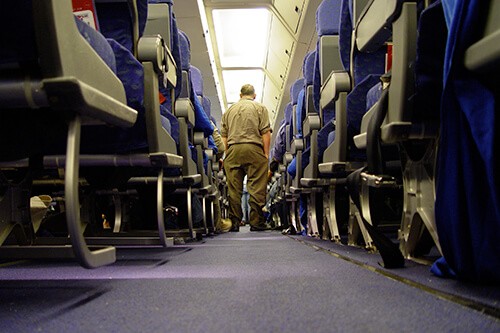With the arrival of spring and summer, many people’s thoughts turn to travel. But long-distance travel often means long hours confined to an airplane or car seat, which can lead to sluggish circulation and potentially serious problems, such as blood clots.
If you are planning a long-awaited vacation or if a business trip is coming up for you soon, there are some important things you should know before you go. Studies show that the risk for developing a blood clot during a long-distance flight is between 3% and 12%[1]. And you don’t have to have varicose veins or venous insufficiency - even people with healthy circulation are at increased risk[1].

Long-distance travel comes with a particular set of circumstances that contribute to this increased risk. There are 7 main risk factors to be aware of. These include:
- The length of time you will be sitting. For example, air flights over 6 hours more than double the risk compared to short flights[1].
- Age – 45% of deep vein thrombosis occurs in those over 40[1].
- Use of Hormone Therapy
- Oral contraceptive use increases risk by up to 40-fold.
- Hormone replacement therapy increases risk by 2.4-fold[1].
- Having varicose veins – increases risk by 19%.
- Being overweight – having a BMI greater than 30[1] increases risk.
- Having a genetic predisposition to clotting – can increase your risk by 8-fold for ground travel and 12-fold for air travel[1].
- Being taller or shorter than average may cause you to have to sit in unnatural positions with little room to stretch your legs. Risk of DVT increases for people taller than 6’2” for all modes of travel and those less than 5’2” for air travel[2].
The good news is it’s possible to keep your legs healthy and significantly reduce your risk for blood clots while traveling. To help make your trails happy we’ve compiled this handy list of simple tips and tricks:
Stay Hydrated
It’s easy to become dehydrated while traveling. In planes, especially, air humidity can be quite low, but this can also happen in other forms of public transportation, such as trains and buses where you aren’t in control of the air conditioning system.
When you’re on a long drive in your car you don’t have ready access to running water or a fridge, so it’s important to plan for your hydration needs. Avoid alcohol and caffeine as these have diuretic effects.
This is not the time to put off hydration in order to avoid having to make stops to use the restroom. Prioritize clot prevention by staying hydrated.
Pull Over for a Break
Take frequent short breaks to stand up, stretch your legs and walk around. Prolonged sitting, which slows blood circulation and promotes clotting, contributes to 75% of blood clots on long air flights[1]. Instead, walk up and down the aisles a few times throughout the trip. Greet your fellow passengers and encourage them to do the same. On long drives make sure to pull into rest stops frequently and walk for a few minutes. The exercise will get your blood moving and the fresh air will invigorate your senses and keep you alert for the next leg of your journey.

Bend and Flex
In between walking breaks, moving your feet can help move blood through your legs by contracting your calf muscles. Take your shoes off to allow full circulation to your feet, flex and point your toes in a paddling motion, make circles with your ankles, and draw the alphabet in the air with your big toe. Each of these little exercises adds up to big benefits for your circulation while you are confined to an airplane or car seat. Also, lean your seat back to stretch your legs, if you have the option, and try pulling your knees up to your chest one at a time and holding for 15 seconds[3].
Wear Compression Stockings
Don’t leave your compression stockings at home when you travel. The use of elastic compression stockings prevents blood from pooling in the lower legs and has been shown to virtually eliminate risk for deep vein thrombosis in patients with standard risk factors during long-distance travel[4].
Wear Loose Clothing
Tight or binding clothing, aside from being uncomfortable, can impair the circulation in the legs, promoting blood clots. You can be both fashion-forward and health-conscious during long-distance travel by wearing loose, stylish clothing.

Ask Your Doctor About Taking Aspirin or a Clot Inhibitor
If you’re in a high-risk category, consider checking with your doctor about taking low-dose aspirin or a clot-inhibiting drug. In one study, 3.6% of high-risk participants who took 400 mg of aspirin daily for three days before a long-distance plane flight developed blood clots compared to 4.8% in the control group[5]. Another group received the clot-inhibiting drug heparin. In that group, there were no instances of deep vein thrombosis and one occurrence of superficial thrombosis.
To find out about your personal risk factors for varicose veins and other vascular problems we invite you to schedule a free consultation at Desert Vein and Vascular Institute. All of our physicians are board-certified vascular surgeons who specialize in helping people improve their vascular health.
Desert Vein and Vascular Institute is the top provider of VenaSeal™, the leading outpatient varicose vein treatment, in the USA. Schedule a free consultation today by calling 1-800-827-4267.
References
- Air travel and the risk of thromboembolism. Intern Emerg Med, 2011. 6(2): p. 113-6
https://pubmed.ncbi.nlm.nih.gov/21057984 - Travel-related venous thrombosis: results from a large population-based case control study (MEGA study). PLoS Med, 2006. 3(8): p. e307
https://pubmed.ncbi.nlm.nih.gov/16933962 - Blood Clots and Travel: What You Need to Know. Available from:
https://www.cdc.gov/ncbddd/dvt/travel.html - Prophylaxis for travel-related thrombosis? Yes. J Thromb Haemost, 2004. 2(12): p. 2089-91
https://pubmed.ncbi.nlm.nih.gov/15613009 - Venous thrombosis from air travel: the LONFLIT3 study--prevention with aspirin vs low-molecular-weight heparin (LMWH) in high-risk subjects: a randomized trial. Angiology, 2002. 53(1): p. 1-6
https://pubmed.ncbi.nlm.nih.gov/11863301
